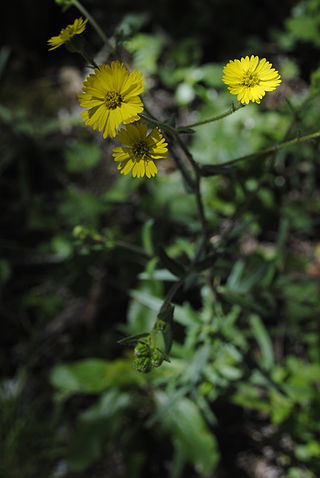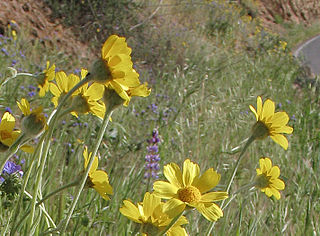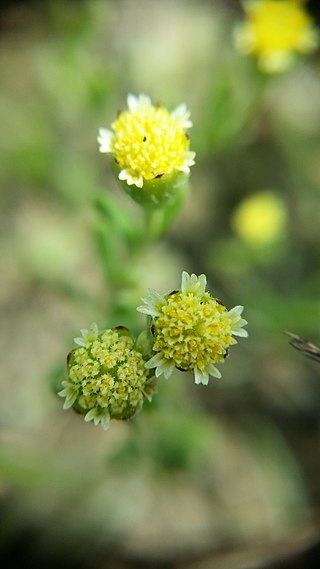
Eatonella is a North American genus of plants in the family Asteraceae containing the single known species Eatonella nivea, which is called by the common name white false tickhead. This small annual is native to the western United States, particularly the Great Basin, where it grows in sandy soils. It has been found in Washington, Oregon, Idaho, Nevada, and eastern California.

Gutierrezia californica is a North American species of flowering plant in the family Asteraceae known by the common names San Joaquin snakeweed and California matchweed. It is native to California and Arizona in the United States and Baja California in Mexico. It grows in sunny sandy or rocky areas in grasslands, scrub, or open woodlands.
Isocoma arguta is a rare species of flowering plant in the family Asteraceae known by the common name Carquinez goldenbush. It has been found only in Solano and Contra Costa Counties in California, where it grows in the Sacramento-San Joaquin River Delta. It is a resident of Suisun Marsh. It thrives on alkali flats and other mineral-rich soils.

Layia heterotricha is a species of flowering plant in the family Asteraceae known by the common name pale yellow tidytips, or pale yellow layia.
Layia leucopappa is a rare species of flowering plant in the family Asteraceae known by the common name Comanche Point tidytips, or Comanche Point layia.
Layia munzii is a rare species of flowering plant in the family Asteraceae known by the common name Munz's tidytips, or Munz's layia.
Layia pentachaeta is a species of flowering plant in the family Asteraceae known by the common name Sierra tidytips, or Sierra layia.

Coreopsis douglasii is a species of flowering plant in the family Asteraceae known by the common name Douglas' tickseed. It is native to California from Santa Clara County to San Diego County, as well as from Mohave County in Arizona.
Eriophyllum congdonii, known by the common name Congdon's woolly sunflower, is a rare California species of flowering plant in the family Asteraceae.
Lessingia tenuis is a species of flowering plant in the family Asteraceae known by the common name spring lessingia. It is endemic to California, where it is known from the San Francisco Bay Area to Ventura County. It grows on the slopes of the California Coast Ranges in common local habitat such as chaparral.

Anisocarpus madioides is a North American species of flowering plant in the family Asteraceae known by the common name woodland madia.

Monolopia is a genus of flowering plants in the family Asteraceae.

Blepharizonia is a genus of flowering plants in the family Asteraceae. There are two species, both endemic to California. They are known generally as big tarweeds.

Laphamia inyoensis, known by the common names Inyo rockdaisy and Inyo laphamia, is a rare species of flowering plant in the aster family.

Arnica dealbata is a species of Californian plants in the tarweed tribe within the aster family

Deinandra bacigalupii is a rare species of flowering plant in the family Asteraceae, known by the common names Livermore tarplant and Livermore moonshine. It is endemic to Alameda County, California, and is only found within a half-mile of the city limits of Livermore, in the eastern portion of the Livermore Valley. The plant is considered endangered under the California Endangered Species Act, and there are only four known populations; a fifth was destroyed by a landscaping business in 2014. The majority is located on city property near the Springtown neighborhood. It grows in open areas with alkali soils, in alkali meadows and on the edges of alkali sinks, and appears to be restricted to a soil called Solano fine sandy loam. This plant was previously included within Deinandra increscens ssp. increscens, but it was separated and elevated to species level in 1999.

Hymenoxys texana is a rare species of flowering plant in the aster family known by the common names prairie dawn, Texas prairie dawn-flower, and Texas bitterweed. It is endemic to Texas, where it is known only from the general vicinity of Houston. It is threatened by the loss of its habitat. It is a federally listed endangered species of the United States.

Erigeron maguirei is a species of flowering plant in the family Asteraceae known by the common names Maguire daisy and Maguire's fleabane. It is endemic to Utah in the United States. It is a perennial herb growing up to 28 centimetres tall. It grows from a taproot and a branching caudex. The stems are densely hairy. The inflorescence holds one to five flower heads each with several hairy, glandular phyllaries. The head has up to 20 white, pink-tinged, or pink ray florets 0.6 to 0.8 centimeters long, and many yellow disc florets at the center.

Deinandra mohavensis, commonly known as Mojave tarplant or Mojave tarweed, is a species of flowering plant in the family Asteraceae.

Hymenothrix dissecta is a North American species of flowering plants in the family Asteraceae known by the common names yellow ragweed and ragleaf bahia. It is native to the western United States as far north as the Black Hills of South Dakota and Wyoming, as well as in northern Mexico.















